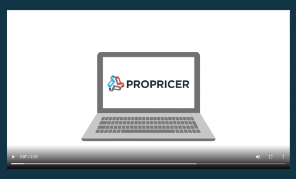We have great news for you: Your firm may be able to start bidding higher in government contract negotiations.
Perhaps you’re bidding low because you think you’re supposed to reduce your margin on government projects. But that’s not true. In fact, according to the Federal Acquisition Regulation:
- Profit is a good thing because it motivates you, the contractor, to execute the contract efficiently.
- It’s not in the government’s best interest to negotiate price decreases that unfairly cut your profits.
- Contracting officers don't have to analyze your profit unless your price negotiation is based on cost analysis.
The government fully acknowledges that your firm deserves to profit from your contracts. The question is: how much?
What to consider as you set a profit margin
If you’re negotiating a cost-plus-fixed-fee contract for experimental, developmental, or research work, your fee can’t exceed 15 percent of your estimated overall cost, excluding the fee. But that doesn’t mean 15 percent should be the profit ceiling on all government contracts.
Another consideration is weighted guidelines. The cost-efficiency factor of weighted guidelines incentivizes you to reduce project costs. It stipulates that contracting officers may increase prenegotiation profit objectives by a modest amount if the contractor demonstrates cost reduction efforts. But weighted guidelines only apply to negotiated contracts in which contracting officers obtain certified cost or pricing data—a relatively small number of contracts. So, don’t let your experiences with weighted guidelines affect your calculation of profits on projects that don’t involve them.
There’s also the notion that if you want to land government clients and keep them, you must do it through discounts. Although government agencies will accept prompt payment discounts, they won’t consider them as they evaluate proposals—and they certainly don’t accept discounts beyond what you would offer your other clients in similar circumstances.
Start high and negotiate down
Where does that leave you for government contract negotiations? Our best advice is, to begin with ceiling and floor prices. Start negotiations at your ceiling price and work your way down. Walk away when you’ve gone below your floor price.
One government contract accounting firm believes firms should start negotiating at 30 percent profit for cost-plus-fixed-fee contracts. The firm has seen contractors win bids at 18 to 25 percent profit, which dispels any myths about the “sweet spot” for profits being 10 percent or less.
Protecting your profits from price escalations
Of course, there’s more to protecting your profit margins than simply making more aggressive bids in government contract negotiations. You must also stay on guard against price increases. The best way to do so is to negotiate a material escalation clause. This clause stipulates that if certain building materials experience a rapid rise in price, the contract price will increase accordingly, often by enough to cover overhead and profit as well as the materials cost. The most common type of escalation provision is a “day one escalation,” which measures all price increases in relation to the prices of materials on the day the contract goes into effect.
Contracting officers often balk at material escalation clauses. Increase your chances of getting these clauses in your contract by being as transparent as possible with your potential client. Try wording the clause so that your firm will only adjust the prices of certain highly volatile materials, and only if these prices exceed the as-bid price by a reasonable percentage. And include language stipulating you’ll reduce your fees accordingly if the prices of these materials fall by more than a certain percentage.
How prime vs. subcontractor profit margins can differ
What if your firm will be working as a subcontractor on a contract? Will your profit margins be different during government contract negotiations? According to a study submitted to the Air Force Institute of Technology in 2019, subcontractors don’t generally earn higher median profits than their prime contractors. But subcontractors who show substantial expertise have the potential to earn higher profits than their primes as well as other subcontractors on their contracts. The bottom line is that, as always, it pays to be outstanding at what you do.
Ignore TINA at your peril
As you embark on government contract negotiations, keep in mind that the easiest way to wipe out your profit is to violate the Truth in Negotiations Act (TINA). TINA requires you to provide cost or pricing data when negotiating contracts and subcontracts with values greater than $2 million—or when you’re making changes of more than $2 million to contracts.
The government can come after your firm for a TINA violation if a federal agency audits your project and finds that you failed to disclose relevant cost or pricing data that could have led to a lower price. If they can prove their defective pricing claim, they can recover the overpayment from your firm.
As scary as all of this may sound, there are reliable ways to protect yourself. First, keep in mind that TINA doesn’t apply to a huge percentage of contracts. As we mentioned, you’re safe if your contract value is $2 million or less—and if you keep all changes to the contract under $2 million. Also, it doesn’t apply to any job for which there was adequate price competition or in which the price was set by law or regulations. Keep these exceptions in mind and ask your contracting officer to waive TINA for your procurement if even one of them applies. And, of course, be sure to provide all necessary pricing data as early as possible in the contracting process.
Protect your margins with ProPricer Contractor Edition and BOE Pro
Need a way to accelerate government contract negotiations while protecting profit margins? ProPricer's BOE Pro platform syncs your basis of estimate (BOE) narratives to your cost and pricing calculations in ProPricer Contractor Edition. Use this bundled solution to coordinate your estimating and pricing work so you can document meticulously accurate proposals. You’ll stay closer to your profit ceiling than your competitors who struggle just to meet submission deadlines. Get started with a demo pre-call now >




